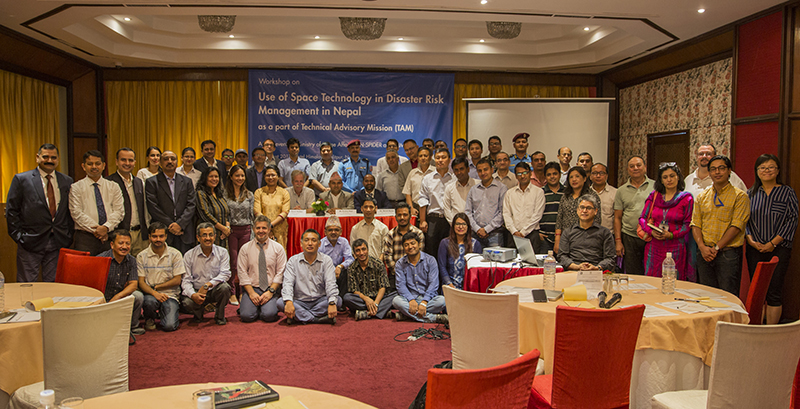
Photo: The UN-SPIDER TAM team presented an all-day workshop in Kathmandu, Nepal about the use of geospatial and space-based technologies for disaster risk reduction and response. Delta State’s GIT Center Director Talbot Brooks provided several blocks of instruction to the group and moderated a roundtable discussion.
The Delta State University Geospatial Information Technologies Center (GIT) continues to make a global impact.
Talbot Brooks, the center’s director, traveled to Nepal this summer to take part in a technical advisory mission to evaluate the current and potential use of space-derived information in all aspects of disaster management and emergency response in the country.
The mission, from July 31-Aug. 4, was conducted upon request from the Ministry of Home Affairs and with the technical support of the International Center for Integrated Mountain Development (ICIMOD). ICIMOD is one of the 21 regional support offices of the United Nations SPIDER program (UN-SPIDER).
Brooks frequently travels abroad in this capacity as a member of UN-SPIDER’s Technical Advisory Mission (TAM) team.
UN-SPIDER provides a mechanism for sharing satellite imagery and similar space-based data from both private companies and government-funded space programs, free-of-charge during times of crisis, through the UN’s International Charter on Space and Major Disasters.
Along with Delta State’s GIT Center, the mission team was comprised of nine experts from the United Nations Office for Outer Space Affairs, UN-SPIDER, ICIMOD, Chinese Academy of Sciences, United Nations Office for the Coordination of Humanitarian Affairs, United Nations Affiliated Center for Space Science and Technology Education for Asia and the Pacific hosted by Indian Space Research Organization and DigitalGlobe, Singapore.
“The Nepalese suffered devastating losses during the earthquake of 2015 — as many as 9,000 people were killed, and approximately 22,000 suffered serious injuries,” said Brooks. “This experience served as a motivator to develop better plans and policies for leveraging the resources available by UN-SPIDER and through the International Charter for reducing the risk of loss to future disasters.”
The team visited key stakeholder agencies contributing to disaster management to take account of current policy and gaps, availability of geospatial information, current use of space-derived information, data sharing practices, applications of geospatial information, challenges and constraints, existing capacity and needs, institutional linkages and coordination, and applications to strengthen disaster risk reduction and emergency response.
“Beyond playing an international leadership role, the GIT Center and Delta State benefit from participation in this program as the United Nations often funds grants and contracts based upon the findings of technical advisory missions,” added Brooks. “Relationships with sister universities formed during TAMS have resulted in several memorandums of understanding with schools in the Republic of Georgia and Vietnam, and international students from these countries will begin attending classes with DSU in the coming year.”
When appropriate, Brooks said GIT students participate in the TAM process and are invited to attend missions, help with the reporting process, and present at UN-sponsored events.
UN-SPIDER will continue to work with Nepal to implement recommendations of the technical advisory mission. Learn more about the program at http://www.un-spider.org/.
Learn more about opportunities at Delta State’s Center for Interdisciplinary Geospatial Information Technologies at https://www.deltastate.edu/college-of-arts-and-sciences/center-for-interdisciplinary-geospatial-information-technologies/.
The mission of the center is to provide geospatial services, accessible education and training, and institutional knowledge for geospatial information technologies to the widest possible audience, and particularly, the mid-Delta region.

